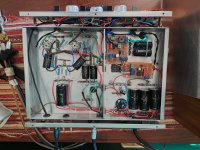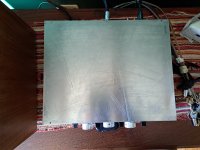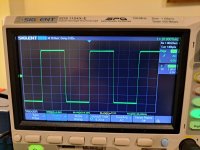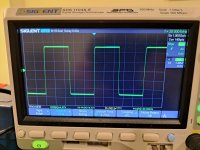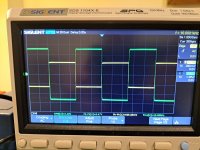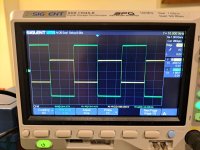Hello. I have a tube amp that makes the noise that can be heard on the attached audio sample.
Whats is that called? Motorboating? What generates it?
Regarding the 50Hz hum, please take note that I have a really high sensitive speakers. That is not loud at all. Thank you!
Whats is that called? Motorboating? What generates it?
Regarding the 50Hz hum, please take note that I have a really high sensitive speakers. That is not loud at all. Thank you!
It sounds to me what we would call squegging, a circuit that alternately block and releases.
Schematic?
Jan
Schematic?
Jan
just in case I will try it this afternoon with a different power amp and a different location in the house. I want to make sure its not due to external interference
Curious about the choice of a 2.2uf between stages, a 0.22uf would be fine there and depending on what impedance this is driving, a 2.2uf on the output might not be enough. Are you sure the PS is clean and the stages are decoupled from each other? That's a weird sound I've never heard from a tube amp before.
Ps is pretty clean yeah. You know what? As soon as I cover the circuit as shown in the second photo below, I get rid of 80% of the noise. I probably want to shield the thing with a thicker metal. And not aluminum
Attachments
22nF would be enought.Curious about the choice of a 2.2uf between stages, a 0.22uf would be fine there and depending on what impedance this is driving, a 2.2uf on the output might not be enough. Are you sure the PS is clean and the stages are decoupled from each other? That's a weird sound I've never heard from a tube amp before.
Too large caps increases leaking and causes strange effects.
Your B+ needs to be free of noise. Then you can lift the heater to 30v which will lower heater hum. I did this with 6922 and get 110db s/n at 1 watt.
I also used nothing bigger then .22 uF coupling cap between stages.
I also used nothing bigger then .22 uF coupling cap between stages.
That's very high are you sure that's within the valve specification?Thanks for you all guys suggestions. I have heaters elevated 90volts.
That suggests that the amp is oscillating at a frequency above audio frequency.You know what? As soon as I cover the circuit as shown in the second photo below, I get rid of 80% of the noise.
R10, R14, R11 look to me like they are going to oscillate.
The speaker wiring may be picking up RF and starting the oscillation going.
If you could look around with a scope you would see the oscillation.
Alternatively get a MW LR transistor radio and hold it near the amp, tuning the radio you might hear the amp oscillating.
The amp looks very well constructed. The layout here may be a problem as regards oscillation:
Last edited:
Hello richgwilliams. Thank you for your comment.
Max Vhk in this 6922EH is 200V. I have the cathode at 160V and elevated the heater 90V.
I do not see anything strange with the scope.
What do you suggest regarding the wiring?
I might test just the left channel, taking out the right channel tube.
Max Vhk in this 6922EH is 200V. I have the cathode at 160V and elevated the heater 90V.
I do not see anything strange with the scope.
What do you suggest regarding the wiring?
I might test just the left channel, taking out the right channel tube.
Have you tried swopping the tubes ?
All the circuit around U1 is high impedance maybe the pickup is getting into the wiring between your preamp and your amplifier?
Are you sure your capacitor C5 is not breaking down? The time constant of C5 and 100K resistance is 0.22 Seconds a bit like the repetition rate of your noise.
Try swopping the connectors from preamp to amp around (left swap right)
Replace R16 (and on the other channel with 47K) a lower impedance for U1 to see.
Check that your U1 Cathode voltage (150 Volts) really is close enough to the heater voltage.
All the circuit around U1 is high impedance maybe the pickup is getting into the wiring between your preamp and your amplifier?
Are you sure your capacitor C5 is not breaking down? The time constant of C5 and 100K resistance is 0.22 Seconds a bit like the repetition rate of your noise.
Try swopping the connectors from preamp to amp around (left swap right)
Replace R16 (and on the other channel with 47K) a lower impedance for U1 to see.
Check that your U1 Cathode voltage (150 Volts) really is close enough to the heater voltage.
Last edited:
- Home
- Amplifiers
- Tubes / Valves
- Tube amp noise
